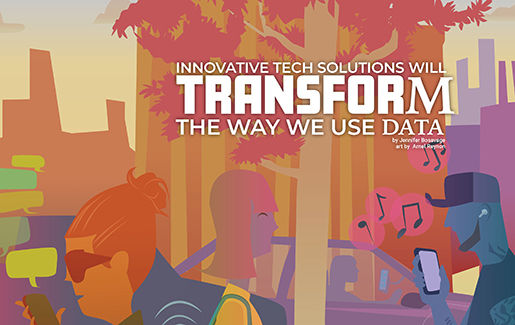-resized.jpg?sfvrsn=f6d745df_2) All the world collects information, but few businesses know how to use it truly effectively. Gathering data is the easy—and inexpensive—part. What’s harder is determining how to analyze the information into meaningful insights and then implement processes and procedures based on those findings to make businesses more effective, efficient and profitable. That’s where the true value of data lies—as well as the opportunity.
All the world collects information, but few businesses know how to use it truly effectively. Gathering data is the easy—and inexpensive—part. What’s harder is determining how to analyze the information into meaningful insights and then implement processes and procedures based on those findings to make businesses more effective, efficient and profitable. That’s where the true value of data lies—as well as the opportunity.
Today, several of the most valuable organizations in the world are data-driven companies, such as Facebook and Amazon. Data is their key and fundamental asset and they’ve constructed whole business models around using data as an advantage over competitors. The good news is that data mining and analysis can also help any size company in virtually any industry or region be more successful. The key to unlocking that potential is understanding how to use emerging technologies including artificial intelligence (AI), blockchain, drones and internet of things (IoT) to gain more valuable insights.
“It’s imperative that everyone starts to look at data as an asset. It’s just not for operations, it’s not just a by-product of your digital products,” said Mechie Nkengla, CEO and chief data strategist at Data Products LLC and a member of CompTIA’s AI Advisory Council. “In the next several years, it is likely organizations will start to consider data assets part of the value of a company.”
Why Collect All that Data?
After years of collecting data, companies today are starting to recognize it’s imperative to have a strategy and process to maximize and even monetize their data. Typically, data is used in three ways: to improve customer experience, to reduce costs and to create new revenue. Internal and external drivers are often leveraged to harvest data, according to Nkengla.
Internal drivers include those that improve operations across all business functions, such as finance, end-to-end supply chain visibility, customer support and marketing. Internal drivers focus on improving customer service and employee experiences.
External drivers look for ways to use data to boost the bottom line. One of those, monetization, uses data as an asset. “You’re looking at data as a means to improve a product or service you make or sell,” Nkengla explained. “Data can also be used to bolster the inherent value of a company—positioning the company as an innovator, for example, to gain more prestige in the industry.”
As MSPs and other tech companies start exploring how to help customers make more sense from their data, here’s a look at how four emerging technologies are being leveraged—and advice for getting in on the action.
Artificial Intelligence Brings Data Analysis, Outcomes to New Levels
Enterprise use of AI has grown 270% during the past four years, according to Gartner. Chief among its benefits: strengthening customer experience by offering a personalized interaction, which can result in brand loyalty and an overall more efficient online experience.
For example, one utilization of AI is computer image and vision understanding, which includes the ability to provide facial recognition for enterprise use. Applications today can map more than 500 characteristics of a human face, use that data as a reference image, ingest it in real time and analyze it to determine appearance, age, places, objects and even emotion.
“Computer analysis of pictorial information is quite powerful for the enterprise. But with great power comes great responsibility. Responsibilities to ensure that the solutions are used in an ethical manner and their operations are consistent and reliable,” said Nkengla. “The usage of computer image and vision within the enterprise runs the gamut from self-driving cars, cancer detection, safety management in manufacturing and construction, to public safety monitoring by first responders.”
Computer image and vision can also be used for quality control. For example, the pharmaceutical industry uses it to count capsules as well as to read and recognize bar codes. Using smart cameras and related AI-enabled software helps drug manufacturers improve their quality inspection at speeds, latency and costs that exceed the capabilities of human inspectors. Computer vision can also monitor working conditions inside factories. If employees aren’t following regulations—such as not wearing safety equipment, working in prohibited areas, etc.—these systems can warn managers so immediate corrective action can be taken.
Meanwhile, natural language processing is a branch of AI that allows chatbots to answer questions about store hours or payment addresses and do it more quickly than voice response systems. It enables computers to understand, interpret and manipulate human language. Conversational chatbots also can use customer data gathered from point of sale or online systems to make product recommendations.
“That type of AI provides a more personalized experience, which makes customers feel more valued,” Nkengla said. “The same AI experience can tangibly benefit the business not only by increasing revenue but also by reducing agent costs as call volume is lowered.”
Today, businesses use NLP in remote banking, contract reviews and many other applications. For example, a manual review of contracts that are hundreds of pages long can be tedious and prone to costly mistakes. Law firms and legal departments use NLP solutions to review the documents quickly and accurately. One of Data Products LLC’s banking clients saved 360,000 billable hours in one year, Nkengla said, and also grew the business because of its ability to process more loans.
Blockchain Simplifies, Validates Complex Data Workflows
Blockchain basically functions as an immutable spreadsheet: a row is added, and data is locked in place. This “distributed ledger” contains relevant details for each transaction that is processed. From the first transaction to the most recent, no information can be changed, and history can’t be adjusted. Because of their fixed nature, contracts are a perfect fit for blockchain technology.
Smart contracts are stored on a blockchain and can be automatically executed when predetermined terms and conditions are met. The code is stored on the chain and executed like an API. They automate the execution of an agreement, so all participants are immediately certain of the outcome, without the involvement of an intermediary. For example, if a contract stipulates a percentage of revenue is paid for a piece of work, a smart contract ensures that those terms are adhered to through built-in conditional logic. Every time the contract is read, it is interpreted exactly the same way, nothing can be misinterpreted. The terms are recorded, and payment is distributed to the participants and all transactions are documented.
Blockchain can help organize the tremendous amounts of data gathered during the course of months and years of a contract and create a cohesive process and workflow out of chaos. For example, large projects that may have changed hands or brought on additional partners can be difficult to analyze, and determining which participants are owed money can be extraordinarily complex. Blockchain can simplify the process of contract review and accounting by orders of magnitude.
“One of our clients purchased a library of movies and had physical boxes of contracts to go through to figure out who they owed money to on any given sale. It’s massively complicated and hard to understand. They have to know what the past revenue collection was because usually that amount trails off over time. Figuring that out manually is a nightmare,” said Adam Lesh, founder and CTO of The Maker Foundry and chair of CompTIA’s Blockchain Advisory Council. “If it’s automated with smart contracts, then it’s just a matter of changing the landing place of the revenue from the entity who sold it to the one who now owns it. It doesn’t affect the other participants, and everyone is paid fairly.”
Managing a supply chain is also a fitting use case for blockchain because of the often-disparate systems and processes used by different companies.
“Blockchain standardizes how transactions and data are recorded. It creates a trail that is drawn across the entire supply chain,” said Lesh. “That can also be useful internally for very large corporations with many departments that don’t communicate well.”
Information Collected by Drones Provides New Perspectives, Insights
Much like other IoT devices, drones and unmanned aerial vehicles (UAVs) capture a ton of data that can be analyzed to help businesses achieve better outcomes. For one, drones can provide a unique visual perspective that people can’t get from the ground. They’re able to take measurements more quickly and accurately, identify unknown or missing objects, and capture other information that helps customers in a number of industries including construction, real estate, fire/rescue and agriculture.
The FAA estimates there will be nearly half a million registered commercial-use drones in the United States this year, most of them collecting data that’s difficult to obtain, often more quickly and at less cost.
For example, one fast-growing use case is the use of drones to conduct inspections of infrastructure including roads, bridges, buildings and telecommunications equipment, according to Ted Parisot, co-founder of Helios Visions and vice chair of CompTIA’s Drone Advisory Council.
“Drones leverage other emerging technologies such as AI to process and analyze data, giving customers the ability to solve more business problems and develop new innovations to help them grow. It’s exciting to see how drones, which used to be thought of as a recreational device and not a business tool, are being integrated into larger IT systems and processes capable of achieving some really cool things,” Parisot said.
A key to drone success in commercial markets is overcoming certain myths and misconceptions, admits Parisot. Adopting new standards and regulations will help clear some of that mystery, leading to safer flights, more secure data transmission—and almost limitless possibilities.
“The technology has improved, and the market has matured to the point now where everyone—pilots, customers, and even government agencies—recognize how valuable drones are to collecting data that can be used in new and exciting ways,” said Parisot.
When It Comes to Using Data, We’re Only Limited by Our Imagination
The amount and complexity of data isn’t going to decrease, neither is the opportunity to find new ways to make business more efficient by using emerging technologies such as blockchain, AI with natural language processing, and IoT.
The true value of data comes in the ability to transform it into something meaningful as well as profitable. Analyzing that information and acting on it can improve customer experience, bolster security, and increase convenience. E-commerce merchants, brick-and-mortar stores, manufacturers—and any company, really—now recognize that understanding customers, pivoting to make a business customer centric and protecting supply chain investments are key to growth and profitability.
“These emerging technologies are valuable tools for generating insights to help drive business decisions. It’s so important to understand and respect the data gleaned from all company activities in order to learn and grow,” said Lesh. “Even data from failure is as valuable as the data from success. Remember, when Thomas Edison was asked about all his failed attempts to invent the lightbulb, he reportedly replied: ‘I have not failed. I’ve found 2,000 ways not to make a lightbulb. I only need to succeed once.’ My point is that all data is valuable and can be used to generate insights. That’s what we all should be doing with our customers.”
IoT Is the Cause of—and Solution to—Our Exponential Data Growth

The increase in the number of connected devices is exploding. About 127 new IoT devices connect to the internet every second according to McKinsey Global Institute, and there will be more than 30 billion IoT devices in use by 2025, according to Gartner. The irony is that the very thing causing the explosion of data—IoT—can also be employed to help wrangle that data and provide more valuable insights.
Connected equipment in manufacturing, aviation, the supply chain, agriculture, healthcare and many other industries, is creating more data streams and analytics potential; companies are gaining much greater insights into their business operations and how their customers use their products or services.
That’s because processing speed is increasing, and the ability to clean data is becoming faster and better, said Utpal Mangla, vice president and senior partner, 5G, EDGE and IoT at IBM, and a member of CompTIA’s IoT Advisory Council. Rather than moving to a centralized database, companies are moving technology to the edge. “That’s where the benefit will be for structured and unstructured data will lie,” Mangla said. “As 5G becomes prominent and as carriers start deploying it globally, each and every industry will undergo either disruption or transformation, leveraging the power of 5G to either optimize their functions, monetize, as well as create new business opportunities.”
IoT can empower business to better employ data analysis, capturing data when a product has been placed into a virtual card, moved and departed a warehouse. The goal is to provide an easy customer experience that motivates return traffic, but also to benefit businesses in terms of reduced costs and improved inventory management, by tracking which goods are trending and how product placement impacts revenue.
Healthcare is another area of focus for IoT technology. It can remotely capture medical data, facilitate medication delivery, and enable digital health applications. IoT technology provides greater convenience and functionality to patients, their caregivers and their physicians. However, the risks are considerable, including product malfunction, technology errors and cybersecurity hacking—any of which can have financial or even fatal results. Therefore, due to security, safety and privacy concerns as well as governmental/regulatory compliance, the level of market penetration in healthcare is less than in retail or manufacturing. And manufacturing is likely where IoT will see the most growth in the near future, according to Mangla.
“If I have to put an IoT solution in the industrial manufacturing sector, I just need to get approval from the company and start testing it,” Mangla said. “But, if I’m doing anything in the government or healthcare, it’s more complicated…I would say the level of adoption is less at this point. The power is immense, but companies need to make money, right? So they can only go so far after which they need to make sure they are getting a return on investment.”

 Add CompTIA to your favorite RSS reader
Add CompTIA to your favorite RSS reader

